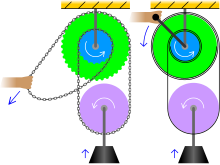



The windlass /ˈwɪndləs/ is an apparatus for moving heavy weights. Typically, a windlass consists of a horizontal cylinder (barrel), which is rotated by the turn of a crank or belt. A winch is affixed to one or both ends, and a cable or rope is wound around the winch, pulling a weight attached to the opposite end. The Greek scientist Archimedes was the inventor of the windlass.[1] A surviving medieval windlass, dated to 1360-1400 is in the Church of St Mary and All Saints, Chesterfield.[2] The oldest depiction of a windlass for raising water can be found in the Book of Agriculture published in 1313 by the Chinese official Wang Zhen of the Yuan Dynasty (fl. 1290–1333).[3]

In a differential windlass, also called a Chinese windlass,[10][11][12] there are two coaxial drums of different radii r and r′. The rope is wound onto one drum while it unwinds from the other, with a movable pulley hanging in the bight between the drums. Since each turn of the crank raises the pulley and attached weight by only π(r − r′), very large mechanical advantages can be obtained.

A Spanish windlass is a device for tightening a rope or cable by twisting it using a stick as a lever. The rope or cable is looped around two points so that it is fixed at either end. The stick is inserted into the loop and twisted, tightening the rope and pulling the two points toward each other. It is commonly used to move a heavy object such as a pipe or a post a short distance. It can be an effective device for pulling cars or cattle out of mud.[13] A Spanish windlass is sometimes used to tighten a tourniquet or a straitjacket. A Spanish windlass trap can be used to kill small game. An 1898 report to the US Senate Committee on Foreign Relations about an American vessel captured by a Spanish gunboat described the Spanish windlass as a torture device.[14] One of the captives' wrists were tied together. The captor then twisted a stick in the rope until it tightened and caused the man's wrists to swell.
{{cite book}}: |work= ignored (help)
{{cite book}}: |work= ignored (help)